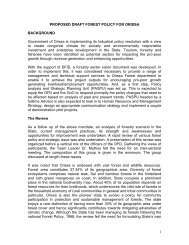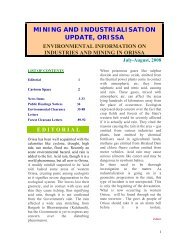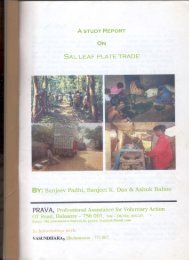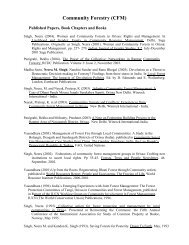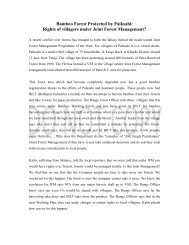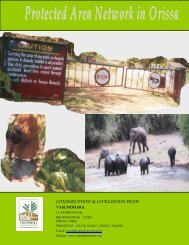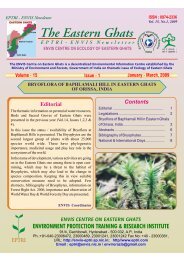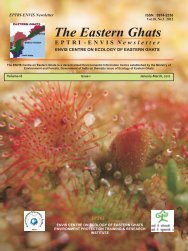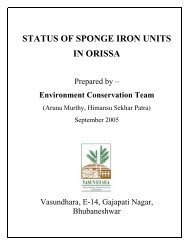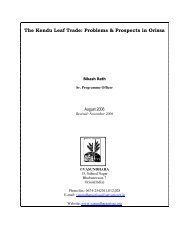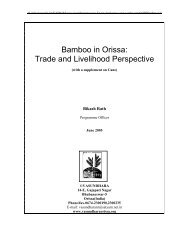DEVOLUTION OF FOREST MANAGEMENT - Vasundhara
DEVOLUTION OF FOREST MANAGEMENT - Vasundhara
DEVOLUTION OF FOREST MANAGEMENT - Vasundhara
- No tags were found...
Create successful ePaper yourself
Turn your PDF publications into a flip-book with our unique Google optimized e-Paper software.
192. Prohibition of carrying cutting instruments to the forest has an implication of lowanthropogenic disturbance. Analysing the anthropogenic pressure in the sampledplots which indicate that 3 sal trees of total 648 trees per ha is seen with branchescut in the Sal belt. No other species in this belt is disturbed. In the Sal belt, thisanthropogenic pressure turns out to be only 0.5% of total trees and 0.7% of totalSal population. In bamboo belt, only one Gamhari tree was chopped off. Theanthropogenic pressure in the bamboo belt noticed to be 0.4% of entire treepopulation. Thus, the strict rule of prohibiting the cutting instruments to theforest drastically reduces the human pressure on it in degrading it. The Sal andGamhari branches are hacked due to its higher timber value.3. Healthy regeneration of bamboo culms are due to selective harvest of maturedbamboos as per operations carried out. Prohibition of bamboo tendrils removalleads to greater regeneration in the culm class 0-10 culms/ clump to 31-40 culms /clump. It is noticed that the regenerating bamboo outnumber the number ofharvested bamboos. This indicate the management practice for bamboo harvest issound. This trend is not noticed in the congested bamboos clumps.4. Analysing the population structure otherwise known as the age class of treespecies in both belts, the trends of most of the species indicate a normal size classdistribution. In general, normal size class disrtibution means the individuals ofyounger age should outnumber their succeeding ones. This class distributionensures maintenance of sustainability in the long run even during the naturalcatastrophes. The existing forest management system of strict vigil over forestsafeguards their regeneration stand which ensures its normal distribution pattern.This deviation is noticed in case of three NTFP yielding species viz. Harida,Bahada and Ganjher. Restrictions on Sal, Mahua and Bija trees which was madeearlier not to touch these timber yielding species at the onset of the committee.But human pressure on these species although noticed to be low, needs to bestrengthened further.This also indicates:1. Forest management initiatives taken by Suruguda villagers is successfullyregaining the vegetatjon cover. The dominance of Sal trees in the Sal belt andbamboo in the bamboo belt are the signs of successful recovery of upper andunderstorey species due to proper protection.2. The management system has taken care of most of the species in the forest. Thesystem also needs to take care of the species that are showing poor regenerationsuch as Harida, Bahada and Ganjher. The frequency distribution pattern of treespecies indicate that most of the species are regaining their vigour safeguardingtheir regeneration stands.3. Some important and economic tree species such as Aanla, Dhaula, Jamu, Karanj,Kendu, Kusum Bel, Ganjher, Kantei,and Simuli are about to attain theirrespective tree size and there has been no pressure on these regenerating stand ofthese species. This is a healthy sign of proper forest management system that alsotakes care of these valuable species to recover.



